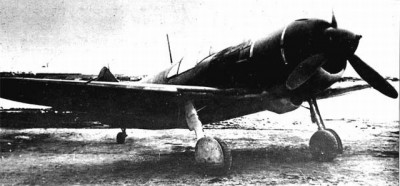| Název: Name: | Lavočkin LaG-5 | Lavochkin LaG-5 |
| Originální název: Original Name: | Лавочкин ЛаГ-5 | |
| Kategorie: Category: | stíhací letoun | fighter aeroplane |
| Výrobce: Producer: | DD.MM.1942-DD.03.1942 Gorkovský letecký závod č. 21 Ordžonikidzeho, Gorkij | |
| Období výroby: Production Period: | DD.MM.1942-DD.03.1942 | |
| Vyrobeno kusů: Number of Produced: | 1 (?) | |
| První vzlet: Maiden Flight: | 21.03.1942 | |
| Osádka: Crew: | 1 | |
| Základní charakteristika: Basic Characteristics: | ||
| Vzlet a přistání: Take-off and Landing: | CTOL - konvenční vzlet a přistání | CTOL - conventional take-off and landing |
| Uspořádání křídla: Arrangement of Wing: | jednoplošník | monoplane |
| Uspořádání letounu: Aircraft Concept: | klasické | conventional |
| Podvozek: Undercarriage: | zatahovací | retractable |
| Přistávací zařízení: Landing Gear: | kola | wheels |
| Technické údaje: Technical Data: | ||
| Hmotnost prázdného letounu: Empty Weight: | 2600 kg | 5732 lb |
| Vzletová hmotnost: Take-off Weight: | 3206 kg | 7068 lb |
| Maximální vzletová hmotnost: Maximum Take-off Weight: | 3303 kg | 7282 lb |
| Rozpětí: Wingspan: | 9,800 m | 32ft 1,82in |
| Délka: Length: | 8,670 m | 28ft 5,33in |
| Výška: Height: | 2,540 m | 8ft 4in |
| Plocha křídla: Wing Area: | 17,62 m2 | 189.66 ft2 |
| Plošné zatížení: Wing Loading: | 181,90 kg/m2 | 37.26 lb/ft2 |
| Pohon: Propulsion: | ||
| Kategorie: Category: | pístový | piston |
| Počet motorů: Number of Engines: | 1 | |
| Typ: Type: | Švecov M-82 vzduchem chlazený dvouhvězdicový čtrnáctiválec o vzletovém výkonu 1 250 kW (1 700 k) při 2 600 ot./min, 1 125 kW (1 530 k) při 2 400 ot./min v h= 2 030 m, 979.25 kW (1 330 k) při 2 400 ot./min v h= 5 400 m a 612 kW (832 k) při 2 400 ot./min v h= 8 500 m. Vrtule VIŠ-105S trojlistá s nastavitelným úhlem náběhu vrtulových listů o průměru 3 000 mm | Shvetsov M-82, fourteen-cylinder air-cooled two-row engine rated at 1,677 hp at 2,600 rpm for take-off, 1,509 hp at 2,400 rpm at 6,656 ft and 1,312 hp at 2,400 rpm at 17,716 ft and 820.7 hp at 2,400 rpm at 27,887 ft, driving a three-bladed variable-pitch ViSh-105S propeller of 9ft 10.11in diameter. |
| Objem palivových nádrží: Fuel Tank Capacity: | 464 l | 102 UK gallons |
| Výkony: Performance: | ||
| Maximální rychlost: Maximum Speed: | 556 km/h v 6450 m | 345.5 mph in 21161 ft |
| Cestovní rychlost: Cruise Speed: | 510 km/h v ? m | 316.9 mph in ? ft |
| Rychlost stoupání: Climb Rate: | 13,88 m/s | 2732.3 ft/min |
| Čas výstupu na výšku: Time to Climb to: | 6,1 min do 5000 m | 6,1 min to 16404 ft |
| Operační dostup: Service Ceiling: | 9650 m | 31660 ft |
| Dolet: Range: | 630 km | 391.5 mi |
| Maximální dolet: Maximum Range: | 1150 km | 714.6 mi |
| Výzbroj: Armament: | 2x pevný kanón ŠVAK ráže 20,0 mm (po 200 granátech) 2x 50 kg puma FAB-50 | Two 0.79 in SchVAK fixed forward-firing cannon 200 rpg Bomb load: two 110 lb bombs FAB-50 |
| Uživatelské státy: User States: | | |
| Poznámka: Note: | Další informace v práci Chronologický přehled konstrukcí S.A.Lavočkina. Jinak také LaGG-3 M-82. | - |
| Zdroje: Sources: | Václav Němeček, Vojenská letadla III,. 3. upravené a doplněné vydání,. Praha, Naše vojsko, 1992. ISBN 80-206-0117-1. Zbyněk Válka. Stíhací letadla 1939/45, Olomouc, Votobia, 1999 ISBN 80-7198-396-9 Profile Publication No. 147, Lavochkin La-5 / La-7 L+K 1/1978, Letadla 1939 - 45 http://www.ctrl-c.liu.se/MISC/RAM/lag-5.html http://www.airwar.ru/enc/fww2/la5.html www.xs4all.nl http://www.wio.ru/tacftr/lag-rus.htm archiv autora | |
| Period | - |
| Producer | - |
| Type | - |
| Camouflage | - |
| Country | - |
| Pilot | - |
| Production No. | - |
| Serial No. / Evidence No. | - |
| Tactical Marking / Imatriculation | - |
| Name | - |
| Unit | - |
| Base | - |
| Date (DD.MM.RRRR) | - |
| Author | - |
| Print size / 300 DPI | - |
| Published with authors permit | - |
| Author Website | - |
| Period | - |
| Producer | - |
| Type | - |
| Camouflage | - |
| Country | - |
| Pilot | - |
| Production No. | - |
| Serial No. / Evidence No. | - |
| Tactical Marking / Imatriculation | - |
| Name | - |
| Unit | - |
| Base | - |
| Date (DD.MM.RRRR) | - |
| Author | - |
| Print size / 300 DPI | - |
| Published with authors permit | - |
| Author Website | - |
